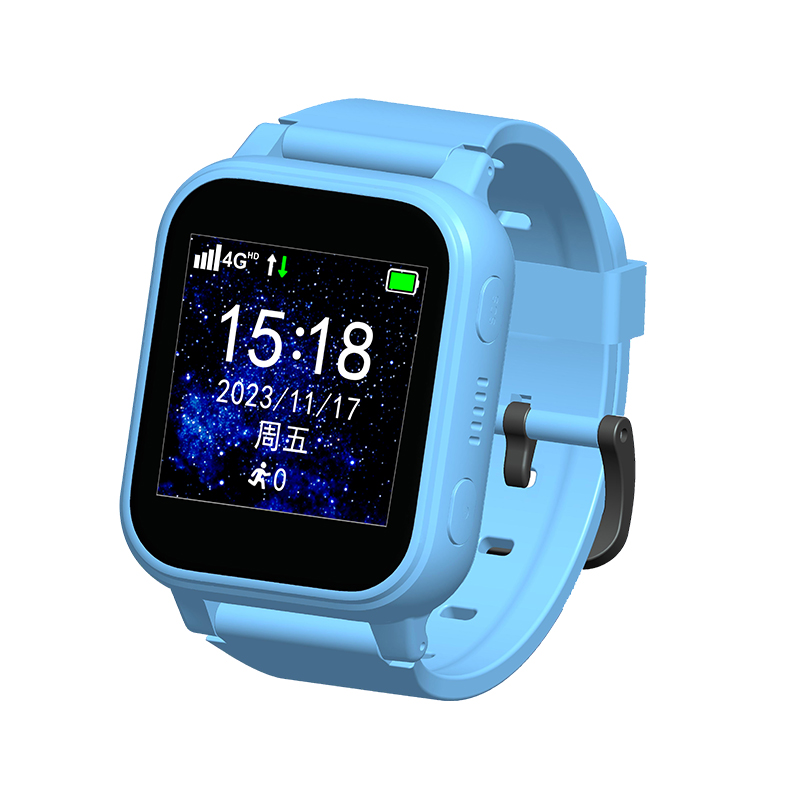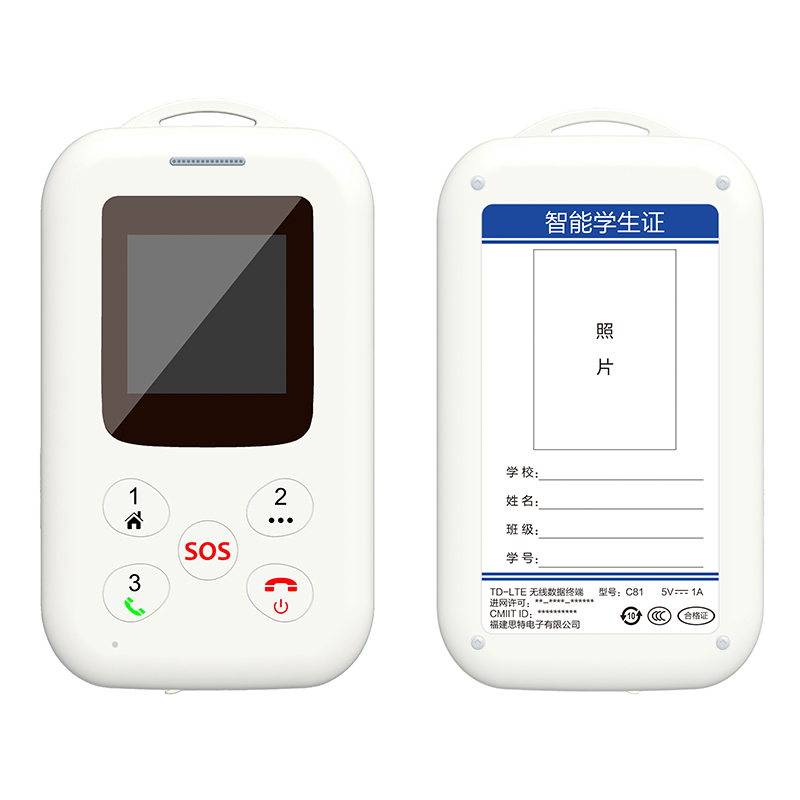Is the 4G kid smart watch's precise positioning reliable in underground garages or densely populated buildings?
Release Time : 2025-10-01
With the accelerating pace of urbanization, issues such as children getting lost or accidentally leaving their parents' care are a growing concern. To enhance child safety, the 4G kid smart watch, with its call, location, and SOS alarm functions, has become a reassuring choice for many parents. Precise positioning is considered a key selling point, with promotional claims often featuring alluring claims like "real-time positioning" and "centimeter-level accuracy."
1. Principles and Environmental Dependence of Positioning Technology
Currently, mainstream 4G kid smart watches generally utilize "multi-positioning" technology to improve positioning success rates. Under ideal conditions, such as open outdoor areas, GPS signal reception is excellent, achieving positioning accuracy of 5-10 meters, which generally meets daily monitoring needs. However, once children enter underground or enclosed spaces, problems arise. GPS relies on satellite signals, which have extremely weak penetration and cannot penetrate thick concrete, metal structures, or underground floors. When children enter underground garages or subway tunnels, the GPS signal is almost completely lost, forcing the watch to rely on location-based services and Wi-Fi for positioning. The accuracy of these two methods is far lower than GPS: Location-based positioning (LBS) in cities typically has an error of 100-500 meters. Wi-Fi positioning, while slightly better, is also limited by database integrity and signal strength, making it equally unreliable in unfamiliar or sparsely located areas.
2. Positioning Failure in Underground and Dense Environments
In underground garages, children's watches often experience "positioning drift" or "location loss" due to multi-layered structures, metal vehicles, and signal shielding. The location of their child displayed on a parent's mobile app may remain at the entrance or randomly jump to a base station several kilometers away, completely losing its true reference value. In densely populated high-rise residential areas, towering buildings create "urban canyons," leading to GPS signal reflections and multipath interference, often resulting in positioning points appearing in the wrong building or even across the street. More seriously, some watches freeze their last valid location when the signal is weak, not updating for extended periods. This can give parents the illusion that their child is still in the same location, delaying their search.
3. Technological Improvements and Practical Limitations
To address this issue, some high-end children's watches have incorporated technologies such as Bluetooth beacon-assisted positioning, barometer altimeter measurement, and inertial navigation. For example, Bluetooth beacons deployed inside shopping malls allow watches to determine relative location based on signal strength; barometers can also assist in detecting floor changes. However, these technologies rely on external infrastructure, have low penetration rates, and are costly, making them yet to become industry standards. Furthermore, even with technological advancements, the laws of physics remain difficult to overcome. Signal shielding in underground spaces is a fundamental challenge, and currently no civilian-grade equipment can achieve high-precision positioning in completely signal-free environments. Therefore, the positioning capabilities of the 4G Kid Smart Watch in underground garages or densely populated buildings are essentially "best efforts" rather than "absolutely reliable."
4. How Parents Should Respond Rationally
Parents should clearly understand that the positioning function of the 4G Kid Smart Watch is a supplementary tool, not a panacea. In high-risk areas, the watch cannot be relied upon to provide real-time location information. The correct approach is to strengthen safety education, teaching children to remember family information, identify dangers, and seek help; maintain close supervision when entering underground or complex areas, and avoid leaving children out of sight; choose a watch that supports multiple positioning functions, has frequent updates, and offers track playback, and regularly check the device's battery and signal status.
In summary, the 4G kid smart watch's precise positioning function significantly decreases reliability in underground garages or densely populated buildings, and may even fail completely. Its technical principles make it difficult to provide accurate location information in signal-blocked environments. Parents should abandon the misconception that "a watch is everything" and combine smart devices with active monitoring to truly build a solid defense for their children's safety. Technology can contribute to safety, but it can never replace parental presence and vigilance.
1. Principles and Environmental Dependence of Positioning Technology
Currently, mainstream 4G kid smart watches generally utilize "multi-positioning" technology to improve positioning success rates. Under ideal conditions, such as open outdoor areas, GPS signal reception is excellent, achieving positioning accuracy of 5-10 meters, which generally meets daily monitoring needs. However, once children enter underground or enclosed spaces, problems arise. GPS relies on satellite signals, which have extremely weak penetration and cannot penetrate thick concrete, metal structures, or underground floors. When children enter underground garages or subway tunnels, the GPS signal is almost completely lost, forcing the watch to rely on location-based services and Wi-Fi for positioning. The accuracy of these two methods is far lower than GPS: Location-based positioning (LBS) in cities typically has an error of 100-500 meters. Wi-Fi positioning, while slightly better, is also limited by database integrity and signal strength, making it equally unreliable in unfamiliar or sparsely located areas.
2. Positioning Failure in Underground and Dense Environments
In underground garages, children's watches often experience "positioning drift" or "location loss" due to multi-layered structures, metal vehicles, and signal shielding. The location of their child displayed on a parent's mobile app may remain at the entrance or randomly jump to a base station several kilometers away, completely losing its true reference value. In densely populated high-rise residential areas, towering buildings create "urban canyons," leading to GPS signal reflections and multipath interference, often resulting in positioning points appearing in the wrong building or even across the street. More seriously, some watches freeze their last valid location when the signal is weak, not updating for extended periods. This can give parents the illusion that their child is still in the same location, delaying their search.
3. Technological Improvements and Practical Limitations
To address this issue, some high-end children's watches have incorporated technologies such as Bluetooth beacon-assisted positioning, barometer altimeter measurement, and inertial navigation. For example, Bluetooth beacons deployed inside shopping malls allow watches to determine relative location based on signal strength; barometers can also assist in detecting floor changes. However, these technologies rely on external infrastructure, have low penetration rates, and are costly, making them yet to become industry standards. Furthermore, even with technological advancements, the laws of physics remain difficult to overcome. Signal shielding in underground spaces is a fundamental challenge, and currently no civilian-grade equipment can achieve high-precision positioning in completely signal-free environments. Therefore, the positioning capabilities of the 4G Kid Smart Watch in underground garages or densely populated buildings are essentially "best efforts" rather than "absolutely reliable."
4. How Parents Should Respond Rationally
Parents should clearly understand that the positioning function of the 4G Kid Smart Watch is a supplementary tool, not a panacea. In high-risk areas, the watch cannot be relied upon to provide real-time location information. The correct approach is to strengthen safety education, teaching children to remember family information, identify dangers, and seek help; maintain close supervision when entering underground or complex areas, and avoid leaving children out of sight; choose a watch that supports multiple positioning functions, has frequent updates, and offers track playback, and regularly check the device's battery and signal status.
In summary, the 4G kid smart watch's precise positioning function significantly decreases reliability in underground garages or densely populated buildings, and may even fail completely. Its technical principles make it difficult to provide accurate location information in signal-blocked environments. Parents should abandon the misconception that "a watch is everything" and combine smart devices with active monitoring to truly build a solid defense for their children's safety. Technology can contribute to safety, but it can never replace parental presence and vigilance.







